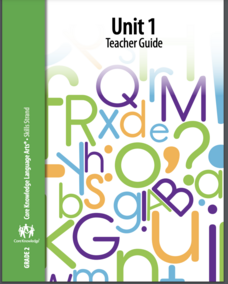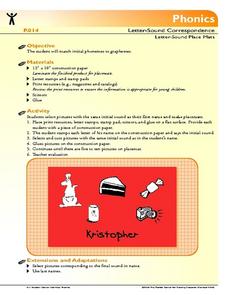Florida Center for Reading Research
Phonics: Letter-Sound Correspondence, Letter-Sound Mobile
Get creative with phonics by having kids create a letter-sound mobile! Learners practice matching medial sounds to their corresponding vowels using a hanger, hole punch, string, and the provided image and letter cards. Students attach...
Florida Center for Reading Research
Phonics: Letter- Sound Correspondence, Brown Bag It
Sorting objects according to their initial sound get scholars thinking about letter-sound correspondence. With 26 brown bags labeled with a letter of the alphabet, learners browse magazines and cut out images that begin with the...
Core Knowledge Foundation
Second Grade Skills Unit 1: The Cat Bandit
For twenty-two lessons over five weeks, scholars practice sound-spelling correspondence, spelling patterns, tricky words, and reading decodable text. Assessments aid in small group formation and gauge comprehension. Lessons begin with a...
Florida Center for Reading Research
Fluency: Letter-Sound Correspondence, Fluency Letter Wheel
Young scholars spin their way to letter sound fluency. While tomes, pairs spin a spinner and make the sound of the letter on which it lands. They add a counter to their cup for each sound they make correctly. At the end of the game,...
Florida Center for Reading Research
Phonics: Letter-Sound Correspondence, Words Around Us Memory Game
Scholars employ memory and letter-sound skills like the classic game Concentration to succeed at this literacy game. Partners choose from rows of upside-down cards, trying to match letters to images with the corresponding initial sound.
Florida Center for Reading Research
Phonics: Letter-Sound Correspondence, Letter-Sound Folder Sort
Practice letter-sound correspondence using an activity that challenges pupils to sort images based on their final sounds. Pairs choose four final sounds to place in an open file folder, take turns selecting image cards, pronouncing the...
Florida Center for Reading Research
Phonics: Letter-Sound Correspondence, Letter-Sound Bingo
Young scholars build a strong understanding of medial sounds, vowels, and letter sound correspondence while playing Bingo. Taking turns, peers choose a card and say its name and medial sound; all players look for the vowel on their card....
Florida Center for Reading Research
Phonics: Letter-Sound Correspondence, Where's That Sound?
The phoneme train is leaving the station! Get your budding readers familiar with letter-sound correspondence using this fun phonics activity. Learners set up the initial and final sound train cards, placing letters between them. They...
Florida Center for Reading Research
Fluency: Letter-Sound Correspondence, Letter Flash
Scholars work in pairs to drill and practice alphabet sounds, keeping track of their progress on a chart. Working one at a time, each partner flips letter cards, saying the sound and letter. If they get it correct, it goes in the YES...
Florida Center for Reading Research
Phonics: Letter-Sound Correspondence, Letter-Sound Pyramid
This fun game is a way to help your littlest learners build strong phonological awareness. Scholars equipped with letter triangles, a stack of picture cards, and counters choose a picture card, say the name of the image, and attempt to...
Florida Center for Reading Research
Phonics: Letter-Sound Correspondence,
What a fun way to practice medial sound-letter correspondence! This alphabet activity has pupils flip cards, determine the medial sound, and place it on one of the train cars if it matches.
Florida Center for Reading Research
Fluency: Letter-Sound Correspondence, Letter-Sound Mix-Up
Scholars time each other as they work through a sheet of all 26 letters. They test each other to see how many letters sounds they can identify in one minute.
Florida Center for Reading Research
Phonics: Letter-Sound Correspondence, Letter Sound Match
Scholars match initial, medial, and final phonemes to individual graphemes. They pick a card, say its name, then find the letter that makes that sound. If the card is a monkey, the learner finds the letter m, matching the grapheme to the...
Florida Center for Reading Research
Phonics: Variant Correspondences, Fishing for Vowel Digraphs
After teaching vowel digraphs, reinforce the concept with an activity! Young scholars fish from a pile of 60 cards to match words with the same sound. Featured vowel digraphs include ea, au, aw, ow, oa, ai, ay, and ee.
Curated OER
Odd One Out
Which word doesn't rhyme? As they practice vowel-sound recognition, scholars examine rows of familiar objects to determine which object doesn't rhyme. There are four rows here, each with a beginning image and three subsequent images....
Core Knowledge Foundation
First Grade Skills Unit 1
First graders participate in skills practice with 32 lessons focusing on sound-spelling correspondence—sound combinations, consonant digraphs, double letter sounds, tricky spellings, and words. Lessons begin with a warm-up, review and...
Florida Center for Reading Research
Phonics: Letter-Sound Correspondence, Letter-Sound Match
Boost initial, medial, and final sound correspondence. Scholars practice decomposing word sounds using image cards and a worksheet. Learners cut out 10 three-letter images, sound them out, and glue them on the worksheet. Each word is...
Florida Center for Reading Research
Fluency: Letter-Sound Correspondence, Make a Match
A memory activity engages young learners in letter-sound correspondence. Pairs take turns examining two sets of cards lying face down. They flip one image card and one letter card, then name the initial sound. If the sounds match, pupils...
Florida Center for Reading Research
Phonics: Letter-Sound Correspondence, Medial Phoneme Spin
A collaborative activity challenges young scholars to match medial graphemes and phonemes. Pairs take turns spinning the spinner, naming the letter, and saying its name. They choose from a stack of cards with the same medial sound.
Florida Center for Reading Research
Phonics: Letter-Sound Correspondence, Letter-Sound Place Mats
Young scholars create personalized place mats as they learn about initial sounds. Using construction paper, they stamp their names using letter stamps. Scholars examine print resources and cut out pictures with the same initial sound as...
Curated OER
What's the First Letter? (A to H)
Here are eight words, and each of them is missing a letter. Not just any letter but the first letter. Oh my! Put your phonics masters to work and have them determine which of the eight letters (a-h) completes each word.
Curated OER
Blending Syllables Name Game
What a fun way to practice segmenting words into syllables! Engage learners by using their own names, spoken by Mico the puppet (or one of your favorites). Mico announces names slowly, syllable by syllable. If scholars have a...
K12 Reader
Change the Verbs to Adverbs
A 10-item worksheet challenges scholars to change verbs to adverbs using their knowledge of adjectives and suffixes.
Florida Center for Reading Research
Phonics: Varient Correspondances, Silent "e" Changes
Engage early readers in a silent e activity to help them understand the changes the letter can make to a simple word. With the provided cards, learners read and write each word as it appears without the silent e. Then they read and write...

























